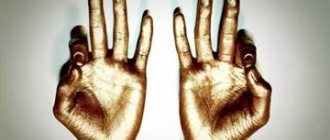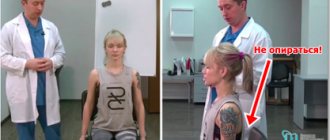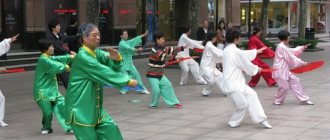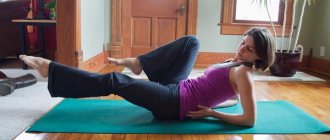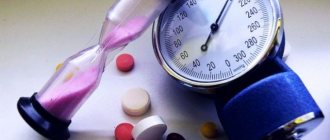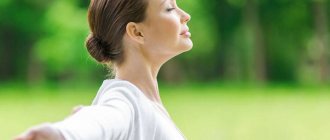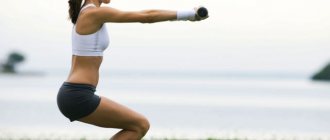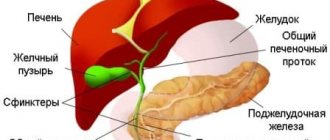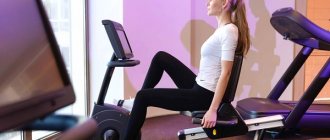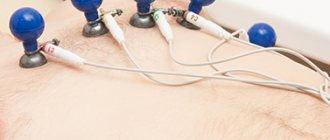Exercise therapy complex for hypotension
For gymnastics to be effective, you must follow simple rules:
- Conduct physical education regularly and systematically. Alternate physical activity, such as dumbbells, and exercises.
- Increase physical activity gradually over a long period of exercise. A minimum of 2 months is required. Don't set the bar high. The increase should be gradual.
As a result of physical exercises:
- Improves blood circulation.
- Stimulates metabolism.
- Supports the body's respiratory system.
Hypotonic patients complain of dizziness and headaches, so it is better to do exercises while lying down.
- Lying on the mat, lift and lower your legs in space.
- Raise your lower limbs in the air, bend your knees and make movements like on a bicycle.
- Raise your lower limbs up and cross them in the air.
- Raise your arms with dumbbells up and down.
- Raise your free arms quickly up and down without dumbbells.
- Bend your lower limbs at the knees, press them to your chest and clasp them with your arms. Now you need to forcefully free yourself from your hands and straighten your lower limbs.
Walking in place is the best exercise for hypotension :
- Start walking in place for two minutes at a slow pace, and then at a fast pace.
- Stretch your arms forward and clench into fists. Walk quickly, while bending and unbending your fists.
- Spread your arms to the sides, walk at a medium rhythm.
- We do a similar exercise with raised arms.
- Place your hands at the waist, raise your legs on your toes, and perform steps in place at an average rhythm for one minute.
- Do the same movement, leaning on your heels.
- Move your body forward, arms at the waist, bend your knees. Move for 15 seconds, half sitting.
- Walk at a slow pace for 30 seconds.
- Walk for two minutes with wide arm swings.
- Swing your left leg forward, backward, right and left, then right.
- Place your feet at shoulder level, gradually lower your arms, touch the floor. We do the same movement with our legs together.
Treatment of hypotension at home
Low blood pressure and exercise
Low blood pressure, or scientifically “ Hypotension ”. This is low blood pressure, which is expressed by low vascular and muscle tone. The term hypotension is also used. People can exercise with low blood pressure. Strength exercises will help cope with this disease. Not only the muscles are trained, but the entire cardiovascular system. Hypotension refers to both chronic constant low blood pressure and sudden temporary decreases. And if a person notices these factors in himself, then the possibility of predisposition to it is high.
Signs of low blood pressure during exercise:
- During strength exercises, you can often feel weak, and fainting is also possible. Very often occurs when training leg muscles.
- The appearance of signs of drowsiness with increasing training time, at the end of the lesson there is a desire to go to bed, yawning appears.
- Feeling dizzy when performing strength exercises, especially when the head is lower than the level of the body. Lying leg curls in a machine, extensions, crunches on a bench, bench press on an incline bench. ⠀
These signs may appear mainly in untrained people. With more training, the body adapts and these symptoms disappear.
The bottom line is that our pressure depends on the width of the blood vessels, as well as the level of glucose in the blood. These factors change when we start training. Under load, blood vessels begin to change, both from aerobic and anaerobic loads. Blood glucose decreases. Its level decreases and so does its pressure. If we take into account that the body is predisposed to this, then together this can give a very serious blow to our body. Even those who have never complained of low blood pressure. This is most often caused by leg exercises. Blood rushes into the legs, and accordingly flows away from the brain and the pressure drops even more.
Factors on which hypotensive training is based:
- When training, you need to have a sweet carbohydrate drink with you. You should drink a sip after each approach. This is necessary to ensure the flow of sugar into the blood.
- It is necessary to do a warm-up. At least for 10 minutes. Warm-up is necessary so that our body is properly prepared for the load.
- It is important to monitor for dizziness. If your head is not dizzy, then you can leave the exercises.
- Legs should be trained at the end of the workout.
- If signs appear that indicate low blood pressure, then you need to eat something sweet.
Learning to breathe correctly
Maintaining a breathing rhythm is an important point during physical exercise.
Correct breathing:
- Through the nose.
- Application of the lower respiratory organs.
- Combining a jerk with an inhalation.
Yoga classes teach you how to breathe correctly. A person can use three types of breathing: upper, middle and lower.
So, what breathing can be used for hypotension:
- Abdominal breathing. In it, we exclude the chest muscles, take a breath, expanding the abdominal area. As you exhale, draw your stomach in as much as possible. Do the exercise 12-15 times.
- Chest breathing. We inhale and expand the chest, while exhaling we release it to the maximum.
- Breathing with the diaphragm. This requires using the diaphragm and chest muscles.
In order to learn rhythmic breathing, you should do the following exercise:
- Inhale for two seconds, exhale for four seconds.
- Add one second to each inhalation, and two seconds to the exhalation.
- We bring the inhalation time to five seconds, and the exhalation will be ten seconds.
Exercise therapy for hypotension with a set of exercises will help eliminate the causes of hypotension. You can add proper nutrition and walks in the fresh air to the complex.
Hypotension: useful tips for normalizing well-being
Hypotension is low blood pressure. Hypotension is a condition in which blood pressure drops below 100/60 mmHg. in men and below 95/60 mm Hg. among women. For older people, blood pressure is below 105/65 mmHg. is already considered reduced.
A tendency to low blood pressure is usually observed from childhood. Such children are lethargic, inactive, and quickly get tired of playing with their peers. Hypotensive adults are characterized by a so-called asthenic constitution - tall height and low weight. Most of them are thin people with pale skin.
Causes of hypotension
The most common cause of hypotension is autonomic vascular dysfunction and pathology of the endocrine glands. Separately, atherosclerotic hypotension is distinguished. This condition is observed in elderly people whose blood vessels are affected by atherosclerosis. Their walls lose elasticity and stop responding to impulses from the autonomic system. The contractile function of the heart also decreases; it pumps blood poorly. Blood pressure may decrease with anemia. This condition is associated with a decrease in hemoglobin content and the number of red blood cells in the blood, which often occurs when there is insufficient intake of iron into the body. The detection of iron deficiency anemia in old age deserves special attention. In these cases, a thorough examination is necessary to exclude a tumor of the gastrointestinal tract, small but regular bleeding from which can lead to the development of this form of anemia. In older men, hypotension often takes an orthostatic form, which is characterized by a sharp drop in blood pressure when the body is transferred from a horizontal to a vertical position. In this case, fainting and convulsions may occur, patients feel weakness in the muscles, noise and “emptiness in the head.” Worsening of health is more often observed in the mornings, in warm weather, after exercise and eating. Doctors believe that this condition is associated with age-related changes in various parts of the peripheral nervous system.
Main signs of hypotension
Manifestations of hypotension: pain and a feeling of heaviness in the back of the head in the morning, accompanied by dizziness and nausea, weakness, fatigue, decreased mood, palpitations and a feeling of interruptions in the heart, lack of air during physical activity. People with low blood pressure often experience coldness and numbness in their hands and feet, and increased sensitivity to heat and cold. Many people complain of sleep disorders.
Emergency care for acute drop in blood pressure:
- the person should be put down as quickly as possible, since in this position the blood supply to the brain is facilitated;
- the head should be positioned as low as possible, do not put a pillow on it;
- if it is not possible to lay a person down, you should sit him down with his head as low as possible between his knees;
— vapors of essential oils have a beneficial effect: just bring a bottle of rosemary and camphor oils or peppermint oil to a person’s nose.
Nutrition tips
A plant such as celery has the ability to increase blood pressure. Patients are recommended to add chopped celery roots to vegetable salads. Among fruits, strawberries have this ability; they can be eaten in large quantities. For hypotension, it is preferable to use vegetable oils in the diet: sunflower, corn, olive, peanut, soybean. From animal fats you can eat butter, cream, sour cream. Lard, beef and lamb fat are not recommended. Recommended foods include nuts, sunflower seeds, and oatmeal. If your health allows and there are no contraindications, you can drink coffee and chocolate. It is important to follow a diet. You need to eat at approximately the same time, at least 4 times a day, in small portions.
Breathing during exercise
In order for exercises to become effective and bring maximum benefits to the body, you need to practice proper breathing during physical activity. The opinion of many doctors agreed on one thing: when performing physical gymnastics, it is advisable to breathe through the nose. Motor movements and breathing must be performed in rhythm.
In addition to physical therapy, there is breathing exercises, which are no less effective in the fight against low blood pressure. Doctors recommend comparing both types of gymnastics; breathing should be done twice: before and after physical activity.
To strengthen the lungs and develop the respiratory system, it is recommended to use various types of breathing. Let's take a closer look:
- Breathing using the diaphragm. This type of breathing involves inhaling simultaneously from the chest and diaphragm. When exhaling, you need to squeeze your pectoral muscles and diaphragm at the same time.
- Breathing through the chest. When inhaling air, we try to expand the chest and fill it with air. When exhaling, we compress the chest and release the air through the nose.
- Abdominal breathing. This technique involves breathing using the abdominal cavity. Inhaling air as much as possible, we try to fill the stomach with air, and when exhaling, the stomach needs to be drawn in.
Exercises for children
Not only adults, but also children are susceptible to low blood pressure. Physical exercises, in other words morning exercises, are recommended for children of all ages. If you start strengthening blood vessels from childhood, the symptoms of the disease can be eliminated at an older age. You should definitely visit a doctor and discuss which exercises will be most relevant for your child. Typically a set of exercises consists of the following:
- Stand on your heels and walk for a minute.
- Stand up on feet. Feet shoulder width apart. With our hands we aim for our toes. First with the right hand to the right leg, then with the left hand to the left leg.
- We stand on the floor, hands on the belt. We perform rotational movements with the torso.
- We get to our feet, hands on our belts. Performed head movements. Head down, up, left, right.
- We alternately jump on the left and right legs for one minute.
- We get on all fours and bend our back down, then up. Perform the exercise for 4 minutes.
- We lie down on the floor with our stomach down. We try to reach the heels with our hands.
- We get down on our knees. In this position we move around the room for several minutes.
- Stand up straight, take the stick in your left hand. We pull our left hand to the right, at the same time we pull our right leg in the opposite direction.
- We lie on our backs, bend our legs at the knees. We try to lift our torso off the floor and bring our chest closer to our knees.
These exercises can only be performed with the permission of the attending physician. Depending on the age of the child, the exercises can be replaced with simpler ones.
In order to effectively get rid of the unpleasant symptoms of hypotension, in addition to performing physical therapy, the doctor prescribes some medications. It is also recommended to follow general doctor's recommendations and preventive measures.
These include daily walks in the fresh air, a balanced diet and proper rest. If you notice that your blood pressure level regularly drops below 90/60, you should consult a doctor, undergo the necessary diagnostics and begin treatment.
